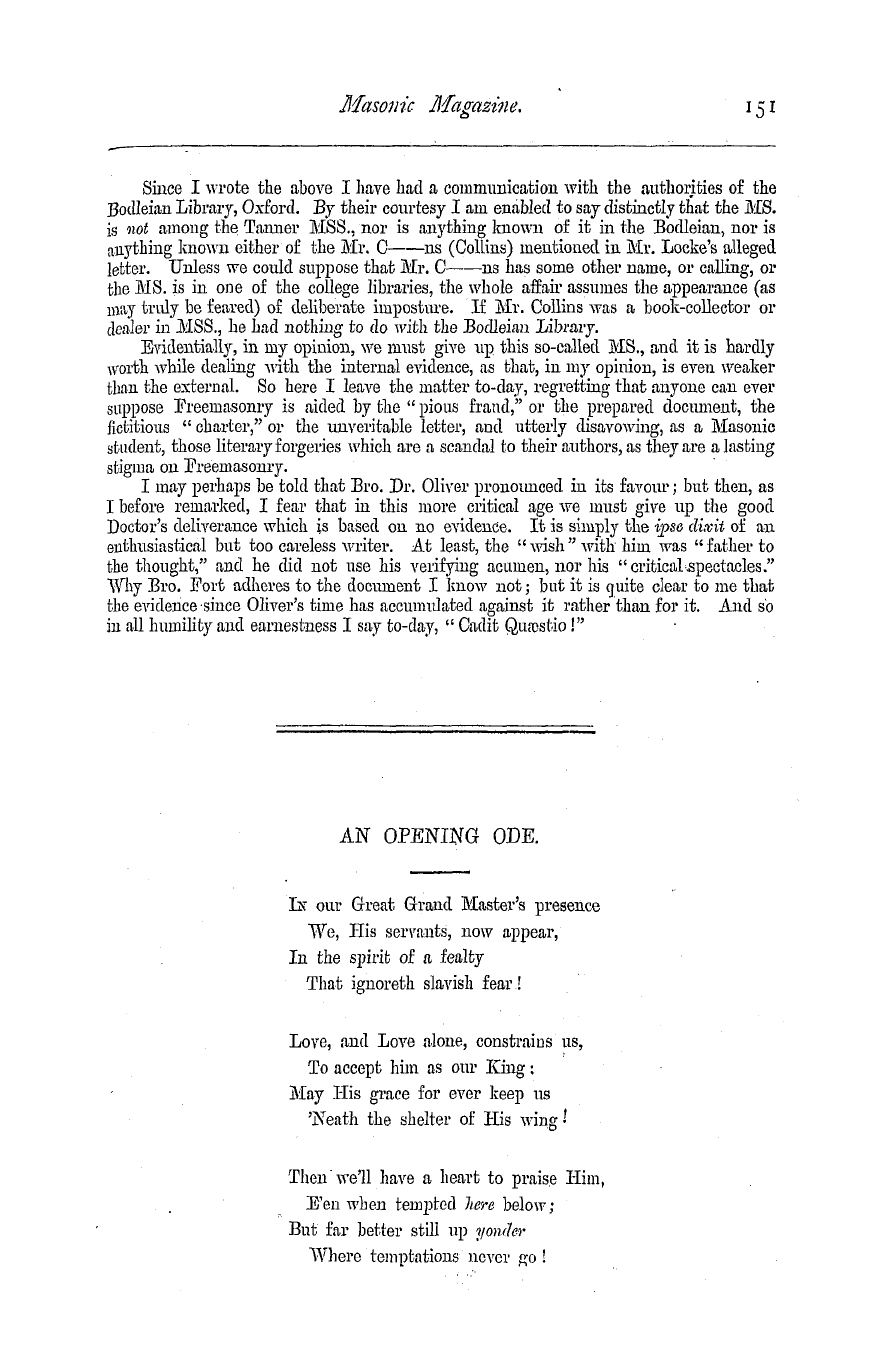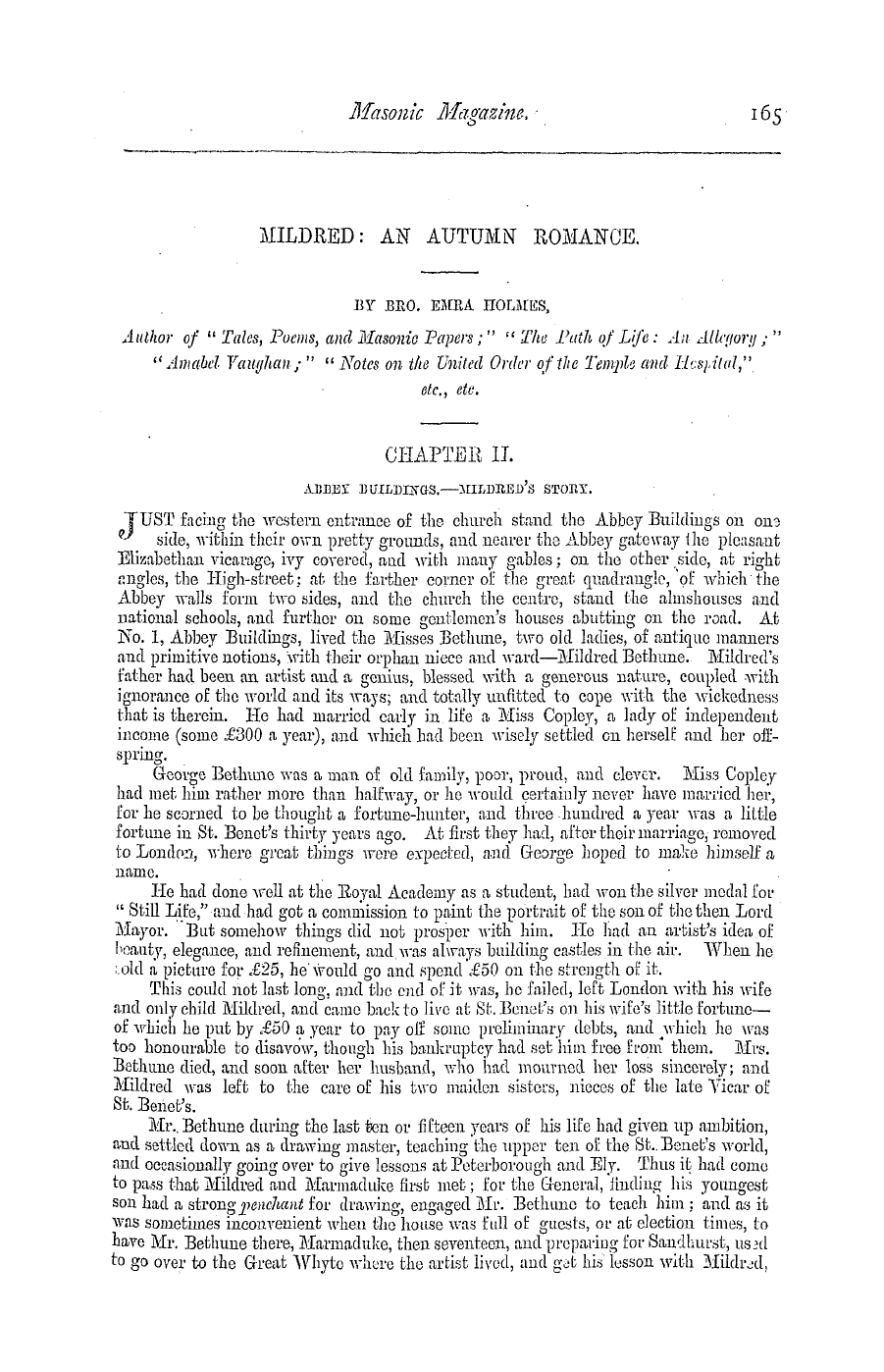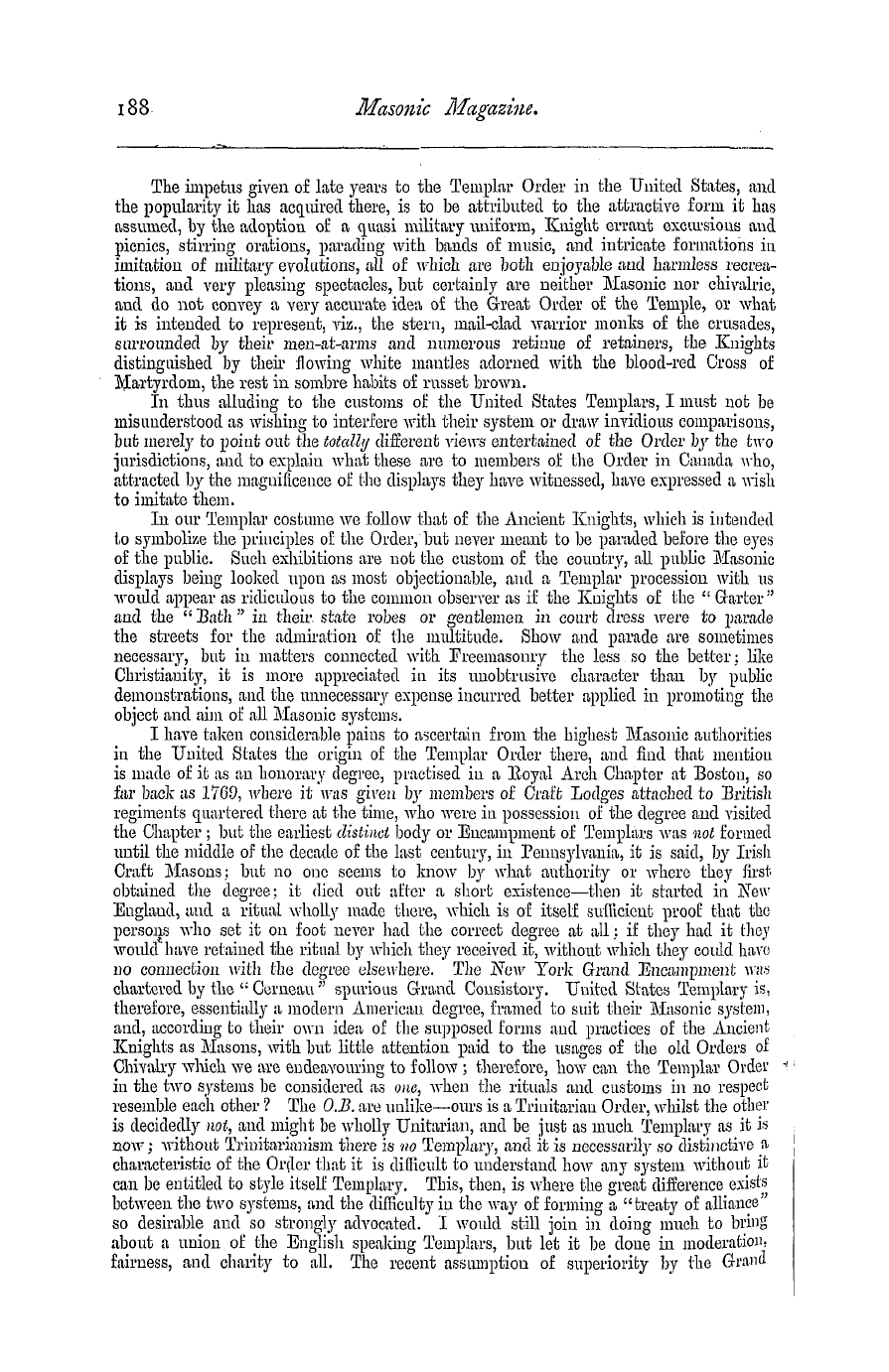Note: This text has been automatically extracted via Optical Character Recognition (OCR) software.
The Modern Order Of "Knights Templar" In The British Dominions.
for so doing is a self-constituted one , in imitation of the early practices of Chivalry , long since fallen into desuetude , which authorized one Knight to create another by oiling the Accolade or dubbing any worthy aspirant . It is therefore looked upon as a ridiculous , although harmless , assumption , to address modern Templars by the title " Sir " added to their names , and has been long discontinued in the British Dominions , unless with the addition of the word " Knight" between it ancl the name ; even this is
considered too much in the style of romance to recommend its adoption on all occasions , und the term " Grade , " when speaking of the divisions or degrees of the Order , is also certainly a very inapplicable innovation . The ancient Templars were known as the " Brotherhood of the Temple , " and the common mode of address to individual members that of " Brother " or " Frater . " This
latter ( Fra . ) as a prefix , does not mean a professed Monk , but simply his brotherhood in the Chivalric Order . Officially , the members were styled " The Knight , " " Knight Preceptor , " " The Sieur of ' -, " etc ., adding their names aud the . designations by which they were commonly known . Much has been said about the landmarks of the Order . The word itself in this sense appears a misnomer , as it is Craft , not chivalric bodies , that , properly speaking , have " Landmarks . "
Templary being iu the strictest sense Christian , it may be'said the whole doctrines of the Christian faith are its landmarks . But to particularize : None can become Templars who do not profess a belief in the Holy ancl undivided Trinity . This is ' of a universal and general application , imperative and indispensable , and provided for in the rides of the Order . It may thus be considered the principal landmark , handed down from the mediooval chivalric fraternities . Another is , that the Masonic candidate should
he a E . Arch Mason ; this degree , being the completion of the Craft , in which a firm belief and trust iu the Supreme Ruler of the Universe is peculiarly inculcated , very properly precedes the Templar Christian belief in the Holy Trinity as an addition to that general recognition of the Deity , ivhich is absolutely necessary and common to the whole Masonic fraternity , not from any supposed connection between the R . Arch and Templar ceremony . Rituals , Signs , Passwords , etc ., can hardly be called landmarks ,
because they differ in some degree in every jurisdiction , even in the Graft , and as they were introduced by Masonic ritualistic compilers are liable to change as circumstance ' s render it necessary . "With respect to the amalgamation of the Templar Order with Freemasonry , all the evidence that can be collected tends to show that in- the middle , if not in the early part , of the last century , the Kt . Templar degree was in possession of the Masonic body , and was practised as an appendage to a higher degree than the Royal Arch , but
that the old Knightly fraternities were in no wise Masonic . It appears to have been the custom in the last century to work degrees that were pot controlled by any governing Grand Body ,, under sanction of a Craft Warrant , that is , iu the Lodge room of a regularly warranted Craft Lodge , and this would seem to be a very proper custom , the presence of the warrant giving a certain degree of legitimacy ta those working iu the higher degrees . No doubt this was the case with the " Kil-Hih Kniht lar Lodof Ireland
jvmuiiig g gTemp ge , " who obtained their warrant in 1770 , irom the Mother Kilwinning Graft Lodge of Scotland . The Irish daughter evidently considered that the warrant gave authority to practise the higher degrees , as almost immediatel y after receiving it the Templar and other high degrees were communicated . -Lhe name of this Lodge would also imply that the Templar degree was previously known hi Ireland , and that the petitioners for the warrant belonged to it , as it cannot tor moment
a be conceived that they deliberately falsified the powers granted them , the more especiall y as the warrant itself was open to inspection . In my opinion , a great mistake is made in looking at this old Kilwinning Warrant from the point of view of « s present clay , and in not considering the very different relations that all Masonic natters bore to each other a century ago . Then it was apparently held that the only correct lawful Masonic authority was the Craft Warrant , and that that warrant covered ° \ ory known degree of Masonry ,
Note: This text has been automatically extracted via Optical Character Recognition (OCR) software.
The Modern Order Of "Knights Templar" In The British Dominions.
for so doing is a self-constituted one , in imitation of the early practices of Chivalry , long since fallen into desuetude , which authorized one Knight to create another by oiling the Accolade or dubbing any worthy aspirant . It is therefore looked upon as a ridiculous , although harmless , assumption , to address modern Templars by the title " Sir " added to their names , and has been long discontinued in the British Dominions , unless with the addition of the word " Knight" between it ancl the name ; even this is
considered too much in the style of romance to recommend its adoption on all occasions , und the term " Grade , " when speaking of the divisions or degrees of the Order , is also certainly a very inapplicable innovation . The ancient Templars were known as the " Brotherhood of the Temple , " and the common mode of address to individual members that of " Brother " or " Frater . " This
latter ( Fra . ) as a prefix , does not mean a professed Monk , but simply his brotherhood in the Chivalric Order . Officially , the members were styled " The Knight , " " Knight Preceptor , " " The Sieur of ' -, " etc ., adding their names aud the . designations by which they were commonly known . Much has been said about the landmarks of the Order . The word itself in this sense appears a misnomer , as it is Craft , not chivalric bodies , that , properly speaking , have " Landmarks . "
Templary being iu the strictest sense Christian , it may be'said the whole doctrines of the Christian faith are its landmarks . But to particularize : None can become Templars who do not profess a belief in the Holy ancl undivided Trinity . This is ' of a universal and general application , imperative and indispensable , and provided for in the rides of the Order . It may thus be considered the principal landmark , handed down from the mediooval chivalric fraternities . Another is , that the Masonic candidate should
he a E . Arch Mason ; this degree , being the completion of the Craft , in which a firm belief and trust iu the Supreme Ruler of the Universe is peculiarly inculcated , very properly precedes the Templar Christian belief in the Holy Trinity as an addition to that general recognition of the Deity , ivhich is absolutely necessary and common to the whole Masonic fraternity , not from any supposed connection between the R . Arch and Templar ceremony . Rituals , Signs , Passwords , etc ., can hardly be called landmarks ,
because they differ in some degree in every jurisdiction , even in the Graft , and as they were introduced by Masonic ritualistic compilers are liable to change as circumstance ' s render it necessary . "With respect to the amalgamation of the Templar Order with Freemasonry , all the evidence that can be collected tends to show that in- the middle , if not in the early part , of the last century , the Kt . Templar degree was in possession of the Masonic body , and was practised as an appendage to a higher degree than the Royal Arch , but
that the old Knightly fraternities were in no wise Masonic . It appears to have been the custom in the last century to work degrees that were pot controlled by any governing Grand Body ,, under sanction of a Craft Warrant , that is , iu the Lodge room of a regularly warranted Craft Lodge , and this would seem to be a very proper custom , the presence of the warrant giving a certain degree of legitimacy ta those working iu the higher degrees . No doubt this was the case with the " Kil-Hih Kniht lar Lodof Ireland
jvmuiiig g gTemp ge , " who obtained their warrant in 1770 , irom the Mother Kilwinning Graft Lodge of Scotland . The Irish daughter evidently considered that the warrant gave authority to practise the higher degrees , as almost immediatel y after receiving it the Templar and other high degrees were communicated . -Lhe name of this Lodge would also imply that the Templar degree was previously known hi Ireland , and that the petitioners for the warrant belonged to it , as it cannot tor moment
a be conceived that they deliberately falsified the powers granted them , the more especiall y as the warrant itself was open to inspection . In my opinion , a great mistake is made in looking at this old Kilwinning Warrant from the point of view of « s present clay , and in not considering the very different relations that all Masonic natters bore to each other a century ago . Then it was apparently held that the only correct lawful Masonic authority was the Craft Warrant , and that that warrant covered ° \ ory known degree of Masonry ,















































